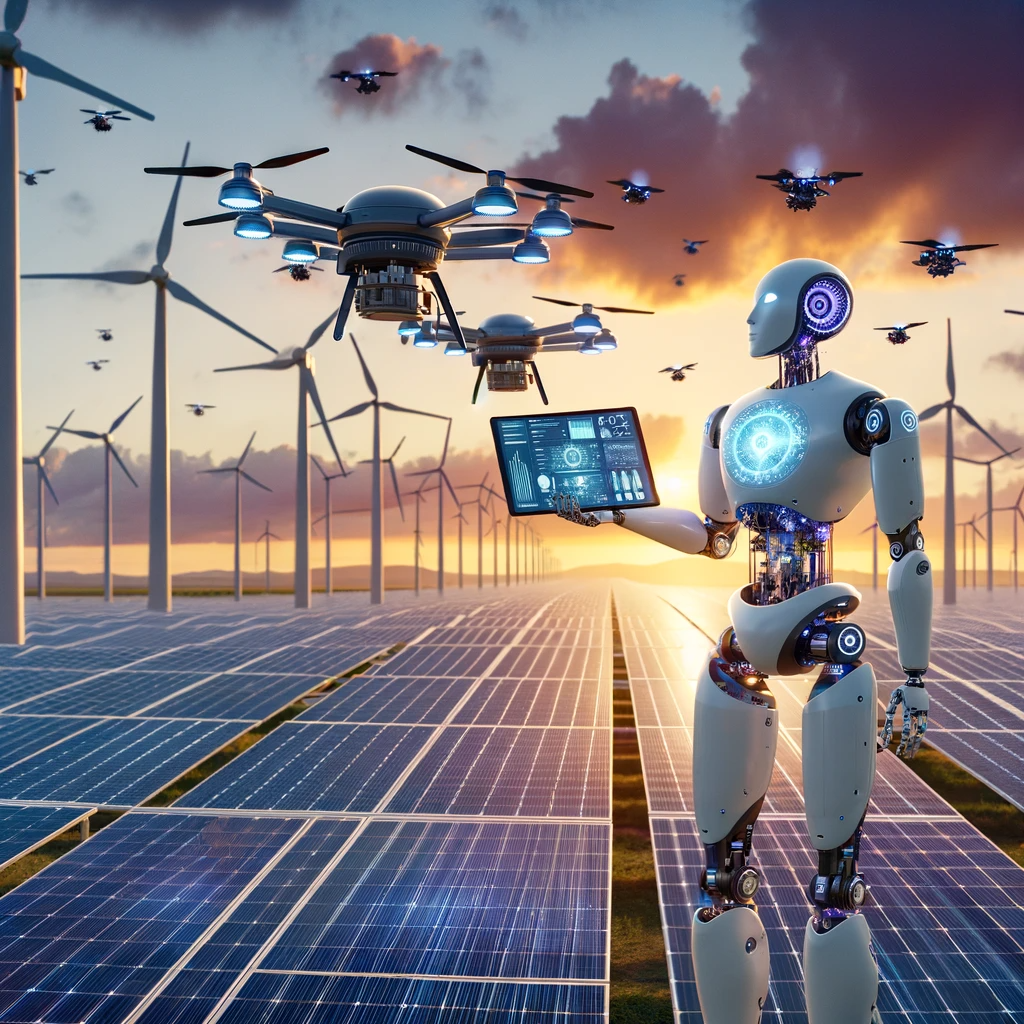Artificial Intelligence (AI) is revolutionizing multiple industries, and the energy sector is no exception. It’s playing a pivotal role in optimizing and enhancing the performance of alternative energy sources like solar and wind power. In this comprehensive exploration, we delve deeper into the substantial impact AI has on these renewable energy sources, fundamentally changing the way we generate, distribute, and utilize clean energy.
Introduction to AI in Renewable Energy
Artificial Intelligence, the field of computer science dedicated to creating smart machines capable of human-like tasks, has found a promising niche in renewable energy. AI’s multifaceted role in this sector goes beyond enhancing efficiency; it’s about creating more reliable, accessible, and sustainable energy solutions. AI algorithms are particularly adept at processing vast amounts of data from renewable energy systems, enabling real-time decision-making for optimal energy production.
Enhancing Solar Power Efficiency
Solar energy represents a boundless source of clean power. However, its efficiency depends on various factors like weather conditions and solar panel orientation. AI-driven solar tracking systems are a prime example of how technology can improve energy capture. These systems automatically adjust the angle and orientation of solar panels to follow the sun’s path throughout the day, maximizing energy generation. Furthermore, AI algorithms analyze weather forecasts to predict cloud cover and adjust solar panel output accordingly, further reducing energy wastage and enhancing overall efficiency.

Optimizing Wind Turbine Performance
Wind turbines harness the kinetic energy of wind to generate electricity, making them a significant player in the renewable energy landscape. AI has a crucial role to play in optimizing wind turbine performance. Predictive maintenance, powered by AI, helps identify potential issues in wind turbines before they escalate into costly breakdowns. Additionally, AI algorithms can optimize the alignment of wind turbine blades to capture the maximum energy from prevailing wind currents. These AI-driven improvements result in increased energy production and decreased maintenance costs, making wind power even more competitive.
Grid Management and Energy Storage
One of the primary challenges in renewable energy integration is balancing supply and demand, given the intermittent nature of sources like wind and solar. AI emerges as the linchpin for effectively managing the integration of renewable energy into existing power grids. By analyzing data from various sources, including weather forecasts and historical energy demand patterns, AI helps grid operators make real-time decisions to ensure a stable supply of electricity. Moreover, AI plays a critical role in managing energy storage systems like batteries. These systems store surplus energy when production exceeds demand, making it available during periods of high demand or when renewable sources are less active, thereby reducing waste and enhancing energy resilience.
AI and Energy Forecasting
Accurate energy forecasting is paramount for grid stability, energy trading, and policy planning. AI-powered models have demonstrated remarkable capabilities in predicting energy production from renewable sources. These models consider an array of variables, including weather patterns, time of day, and historical energy production data. The result is highly precise energy forecasts that enable grid operators to optimize energy distribution, reduce the reliance on fossil fuels during peak demand, and avoid energy shortages.
Machine Learning for Energy Consumption
The application of AI extends beyond the production side of renewable energy. It also plays a significant role on the consumer side. AI-driven energy management systems have the capacity to learn from household or industrial energy consumption patterns. These systems adapt and suggest energy-saving measures to users, such as optimizing thermostat settings, managing lighting systems, or recommending the use of energy-efficient appliances. These proactive AI systems result in reduced energy bills and a diminished carbon footprint, making them a valuable tool in promoting energy efficiency at the individual and organizational levels.
Environmental Impact Assessment
The growth of renewable energy infrastructure must align with environmental sustainability. AI tools and algorithms facilitate rigorous environmental impact assessments (EIA) for renewable energy projects. These assessments consider multiple factors, such as land use, wildlife preservation, and carbon emissions. AI’s involvement in EIAs ensures that renewable energy projects align with sustainability goals and minimize negative environmental effects. This holistic approach fosters the responsible development of renewable energy infrastructure while safeguarding fragile ecosystems.
AI in Energy Policy and Regulation
AI’s analytical capabilities extend to the domain of energy policy and regulation. Policymakers and regulators are turning to AI to design and assess the effectiveness of incentives, subsidies, and regulations aimed at promoting renewable energy adoption. AI analyzes vast datasets, identifying trends and patterns that inform evidence-based policymaking. By providing insights into the economic and environmental benefits of transitioning to alternative energy sources, AI empowers governments and regulatory bodies to design policies that foster a sustainable energy future.
Challenges and Ethical Considerations
The transformative potential of AI in renewable energy comes with its set of challenges and ethical considerations. These include concerns about data privacy, algorithmic bias, and the potential for job displacement in traditional energy sectors. Addressing these challenges and ethical considerations is essential to ensure that the integration of AI in renewable energy is not only efficient but also equitable and socially responsible. Solutions may involve robust data privacy regulations, continuous algorithmic auditing for fairness, and targeted workforce development initiatives to transition employees into AI-related roles.

Conclusion
AI is profoundly reshaping the landscape of alternative energy sources like solar and wind power. Its capacity to analyze vast datasets, make real-time predictions, and enhance system efficiency is revolutionizing the renewable energy sector. As AI technology continues to advance, we can anticipate even deeper integration, resulting in more sustainable and eco-friendly energy solutions. The journey towards a cleaner and greener future is powered by AI, as it drives the effectiveness and accessibility of renewable energy sources, setting the stage for a more sustainable energy landscape for generations to come.
